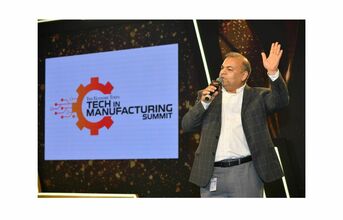
The Adani Group, known for its prominent brands in the cement industry, recently completed an inbound M&A transaction valued at approximately $6.5 million. In this context, when Shah was asked that what digitisation means to him, he replied, "We do not have a choice," highlighting how necessary technology implementation has become in today's world.
He emphasised how Adani Cements is swift with this work and completed the entire acquisition process in merely four months. During this period, the company successfully migrated applications, transitioning from Google to Microsoft platforms and adopting cloud-based solutions. Adani Cements' focus, Shah revealed, primarily lies on manufacturing, with 34 large plants acting as pivotal centers of operation.
Previously have worked for Dell, he shared that the company's heart was its supply chain, and with respect to areas like supply chain manufacturing, the integration of technology is no longer a matter of choice. He underlined the fact that many manufacturing firms, including Adani Cements, are recognising the necessity of adopting technology to remain competitive. This shift is observable across industries, with some companies embracing technology at a faster pace than others. In essence, technology companies engaged in manufacturing are on the rise, demonstrating the transformative power of technology in industrial operations.
Drawing parallels with notable examples, Shah highlighted Tesla as a technology company that manufactures cars, and Amazon as a technology-driven entity functioning as the world's largest warehouse. These companies have successfully harnessed technology to redefine their industries. Adani Cements sees itself on the verge of a phase, wherein technology will not only enable but also radically transform the manufacturing processes.
Shah shared that the goal at Adani Cements is not merely cost reduction but rather optimising operations to achieve higher output with fewer resources. He stressed the importance of digitisation as a means to attain scalability and efficiency in manufacturing. By adopting digitisation in practices, companies can aspire to operate with reduced resources while achieving significantly higher output, a feat observed in global manufacturing players.
He elaborated that, digitisation in manufacturing encompasses various facets, with artificial intelligence (AI) playing a pivotal role. While AI may not be universally applicable, it offers substantial benefits for specific tasks. In heavy manufacturing sectors like cement production, safety stands as a paramount concern. Video-based analytics and AI-driven solutions have emerged as indispensable tools for addressing safety issues effectively.
During the discussion, a question was raised about the CEO's previous statement that every company is a tech company. A recalled conversation with the former CEO was shared where he emphasised the significance of data and technology in their operations. He explained that all the valuable information and insights derived from these technologies formed the foundation for their decision-making processes.
Shah acknowledged the widespread recognition of the usefulness and empowerment brought by artificial intelligence (AI) technologies. However, he emphasised that their organisation was still in the early stages of using data effectively, and shared some specific examples to illustrate the progress they had made thus far.
One notable initiative involved the implementation of a system to monitor the performance of their 34 manufacturing plants. Shah highlighted the need to stay informed about each plant's status on a daily basis. To achieve this, the company's planning team worked until midnight to compile data, which was then sent to their bosses in Ahmedabad. These managers would wake up at six in the morning to review the reports and address any issues that arose.
To streamline this process and alleviate the burden on their employees, the company embarked on a data-driven transformation. Shah revealed that they had built a data lake on Microsoft Azure's synapse platform in just six weeks. Although the implementation phase was grueling and sleepless, the effort was worthwhile. Now, with the system in place, the data from each plant is automatically collected, allowing for prompt decision-making.
He mentioned that the first beneficiaries of this streamlined process were the individuals previously burdened with preparing Excel spreadsheets during late nights and early mornings. While this might seem like a small improvement, it had a significant impact on their overall operations.
Furthermore, Hemal Shah identified their kilns, which are crucial and costly components of their manufacturing process, as a focal point for future data-driven optimisations. By using data effectively, the company aimed to reduce downtime in the kilns. Their goal was to save one day of downtime per kiln within six months, resulting in cost savings of Rs 100 crore.
The CEO acknowledged that they were still in the early stages of this journey, but he expressed optimism about the possibilities that lay ahead. He highlighted the potential for advanced algorithms, data insights, and exception management to replace human monitoring, leading to improved operational efficiency and output.
The discussion further steered towards the importance of data protection because as important as data is, it also carries a huge threat of cyber-attacks which affect India as a nation as well.
Shah then delved into the inherent vulnerability of OT systems, using real-life examples to drive the point home. Shah pointed out that recent incidents, including a hospital cyber-attack, demonstrated the potential harm that could be inflicted on vital services and the safety of individuals. The consequences of OT breaches reach far beyond mere disruptions, encompassing the wellbeing and lives of people who rely on the affected systems.
The discussion then turned to the intertwined nature of information technology (IT) and OT in modern infrastructures. Shah explained that digitising factories necessitates the integration of IT and OT, with data exchange becoming a crucial aspect of operations. However, this integration also introduces a catch-22 situation: if the OT system becomes compromised, it can have severe repercussions on the IT side, jeopardising the entire ecosystem.
To address these challenges, Shah emphasised the importance of accountability and regular auditing. He revealed that his team had recently conducted an audit at their manufacturing facility, underscoring the vulnerability of the manufacturing OT landscape. Shah stressed that organisations cannot afford to turn a blind eye to these risks and must actively assess and mitigate them.
He pointed to the example of Bombay airport, where OT security measures are in place to track and protect all units. This proactive approach ensures uninterrupted services for customers and reinforces the significance of OT security in critical sectors.
He gave a somber reminder of the escalating cyber threats faced by India as it becomes a global manufacturing hub and warned that cyber-attacks on the country's OT infrastructure should be regarded as acts of war, as they have the potential to compromise the safety of individuals and inflict significant damage on a national scale.
When asked about the don'ts to be kept in mind in the adoption of technology, Hemal Shah urged the audience to not ignore the significance of change management in the implementation of digital initiatives. He stressed that the willingness of users to adopt new technologies is paramount, regardless of their technical capabilities. Shah highlighted the need for organisations to prioritise effective change management strategies throughout their digital transformation journeys.
Moreover, Shah discussed the importance of having a deep understanding of customers and their behaviours. Drawing on his experience in the cement business, he shared that he calls it ‘cement ka dhandha' and not ‘cement business'. As a company, they need to connect with customers at a ground level. Shah emphasised the importance of comprehending the behaviours of customers, dealers, retailers, and industry influencers. He noted that without understanding the preferences and needs of these key stakeholders, the implementation of technological changes would likely fail, and stared, "understanding the lens of the customer is most important."
Shah also shared insights on the role of technology professionals in manufacturing and technology-driven organisations. He advised individuals not to confine themselves to office spaces and instead urged them to gain practical experience on the ground. Shah revealed that his team has a policy mandating visits to factories before employment, ensuring that team members possess firsthand knowledge of operational challenges. He encouraged professionals to engage directly with technology in real-world scenarios, irrespective of their roles, to gain a comprehensive understanding of its functioning.
Additionally, Shah warned against the pitfalls of blindly adopting technology without careful consideration. He cautioned against being swayed by buzzwords and advocated for a critical evaluation of the relevance and applicability of technologies. Shah recounted an example where he questioned the practical problem-solving potential of block chain technology, highlighting the need to avoid using technology merely for its high-tech appeal. He stressed the importance of simplicity and value-driven decision-making in the digital transformation process.





































